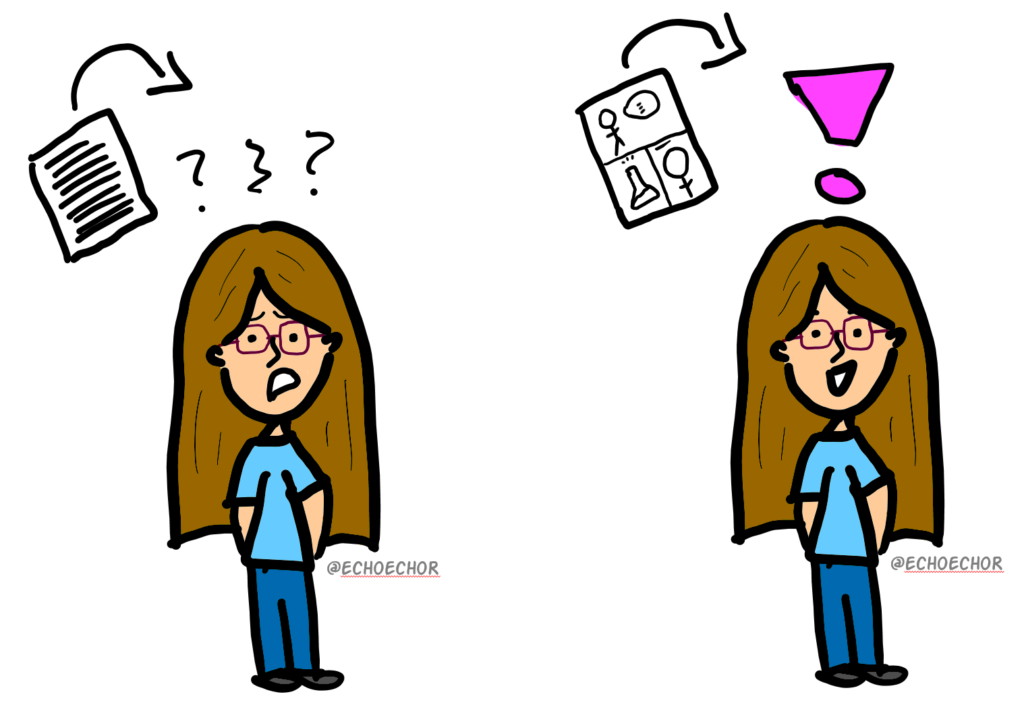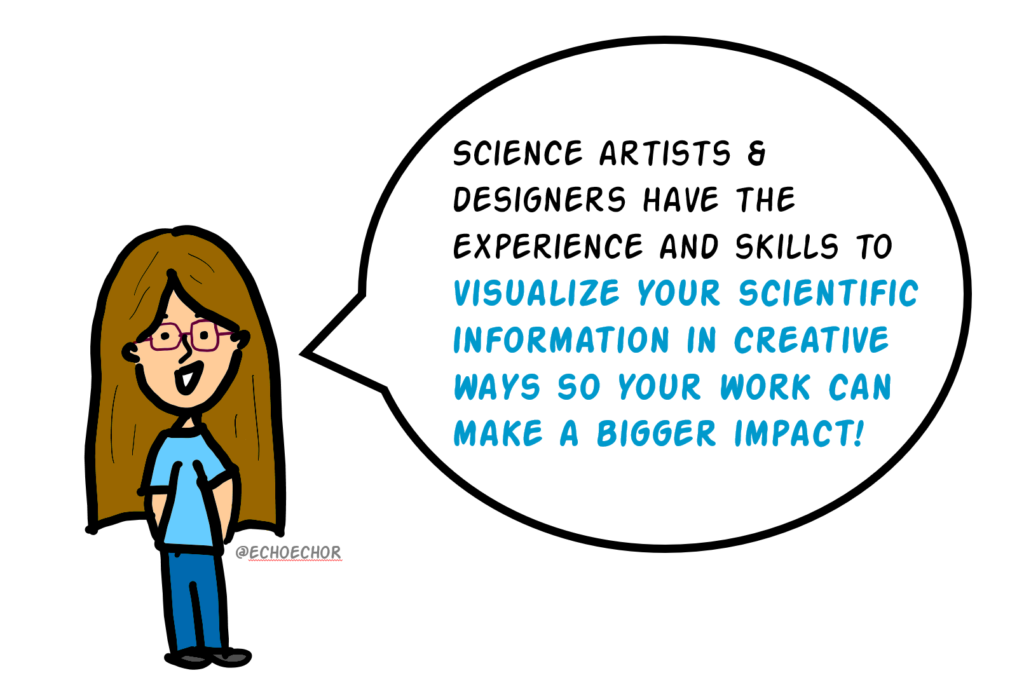When communicating scientific information, have you ever felt limited when using only text or words? Alternatively, have you ever struggled to understand scientific information when it was explained solely through text or spoken word?
Text and words often fall short of being sufficient for effectively communicating scientific information across a variety of contexts and audiences. There is usually an additional component that is needed for effective communication – visuals.
For example, can you read about all the layers in a cell and fully grasp it? If so, you’re actually really lucky. Most people would need to see a scientific illustration of a cell to fully grasp the concept. I know I would!

Yet, many graduate programs don’t include training on how to use visuals for science communication. At best, we learn to create graphs (which usually don’t meet minimum best practices for data visualization, but that’s a post for another day!). The end result is that many scientists want to include more visuals into their work, but don’t know how. Or, they try and it doesn’t make the impact they wanted.
This is where science artists and designers can help. Science artists and designers have the experience and skills to visualize your scientific information in creative ways so that your work can make a bigger impact.

How do artists and designers help scientists?
We help scientists share their work in ways that are creative, resonate more deeply with the audience, and make a bigger impact. That’s a really broad statement, I know. That’s because the specific answer to this question is as varied as the number of artists/designers who are out there, ready to work with a scientist! There is no one type of science artist or designer, and we all work in different ways.
If there is an art or design form, you can bet there will be someone out there who can apply those skills to science. Just some examples to scratch the surface include:
- Animation
- Illustration
- Film and video
- Data visualization
- Poetry
- Spoken word
- Comics and cartoons
- Dance
- Music
- Zines
- Murals
- Graphic design
- Infographics
- Data visualization
- Photography
- Presentation design
- Fiction writing
- Wearable products (jewelry, clothing)
- Games (video and board)
- …and more I’m not even thinking of!
That’s the beauty of this field. Without a doubt, there is an artist or designer who can help you with your project. It’s just a matter of finding the right fit.
If you looked through that list and thought, “I don’t know how to do any of this for science communication,” that’s no problem, because that’s what a science artist/designer is here for! It’s a win-win scenario. Each artist/designer will have a unique combination of skills and will be able to help with (or create) one or more items on that list.
You may have already noticed that I’m using the phrase “artist or designer.” While some may use that interchangeably, they are quite different. In your search for an artist or designer, it may be helpful to know which one you need.
Generally speaking, design is functional and art is about aesthetics (appealing to the senses and emotions). They use similar skillsets but the end products — and how people use/interact with them — are different.
Is your primary goal to have something that is aesthetically pleasing to the senses and/or evokes a very specific emotion? If so, you probably need an artist.
Is your primary goal to communicate data in ways that both resonate with the audience, while also ensuring that they can understand, remember and use the data for some type of action? If so, you need a designer.
That’s a very general and broad way to describe the difference (and many people or companies can do a blend of both!). If you’re interested in learning more about the difference between art and design (and how they can work together in science communication projects), stay tuned for a follow-up blog post.
How can scientists find artists and designers?
Luckily, Lifeology.io is a great place to start. You can find science artists/designers by checking out the member directory, joining us in the Slack community, or posting in the forum.
Beyond that, finding one on social media will probably be your next easiest step. Most science artists/designers are active on Twitter, Instagram, and/or YouTube. I haven’t seen a lot of science artist/designer friends be as active on Facebook as they are on other platforms.
I am most active on Twitter, so I can provide more concrete recommendations for that platform. You can usually find us by checking out the following hashtags:
- #SciComm
- #ScienceTwitter
- #AcademicChatter
- #PhdChat
- #AcademicTwitter
You can use those hashtags and specifically ask “I’m looking for a [insert type of artist or designer], any recommendations?” Fair warning, you will likely be overwhelmed with results!
You can also just use those hashtags to keep an eye out for artists and designers, and then follow them when you see them. I recommend you check out their website and sign up for their email newsletter. I know, I know. If you can’t reach inbox zero, you might hate that recommendation! I recommend that because being on an artist/designer’s newsletter is one of the best ways to stay updated on their work, see their latest examples, and you’ll always have their contact info. Meaning, when you are finally ready to move forward with a project, you won’t have to struggle to think about who to reach out to, or have that moment of “what was that artist/designer’s name?!” We’ve all been there, so getting a newsletter will help speed things up once you’re ready to do a creative project.
Who does what in a given project?
It depends. Some will do the entire project for you, some will train you to DIY, some can provide mentoring, and some can do a combination of the above. It will be helpful if you tell the artist/designer which approach you prefer when you contact them.
For example, I have on-demand online courses about presentation design that scientists can complete at home and at their own pace. I also do professional development workshops to groups (in-person and webinar). And, of course, I will design presentations for scientists. We have also created an online self-paced course to teach scientists how to use Affinity Designer. For the other types of products we do (reports, infographics, illustrations, dataviz for reports, comics), I will create them for the client or mentor them on their own project.
Ultimately, I am flexible and work with each client to best meet their needs while staying within their budget. And many of the artists/designers I know are similarly flexible and have a variety of services to best meet your needs.
What is the process for working with a science artist or designer?
Again, this will vary by artist/designer, but I’ve talked with others and this usually happens in a few core steps:
- There is an initial discussion via email or video call. Many artists/designers will want to know your budget at this stage.
- The scope of work is finalized. A deposit (or full payment in advance) may be required. Some will charge a flat fee, others charge hourly rates.
- The project is completed. There is usually at least 1 revision included, but the number of revisions depends on the budget.
- You have a shiny new creative product to use and share!
How much does it cost? What are standard rates for design or SciArt?
First, let’s get one thing out of the way. Please have a budget for the project and do not ask artists/designers to work for exposure.
Okay, now we can talk about how much a science communication project costs. The biggest misconception is that there is a standard cost for this type of work. Take a moment and imagine that someone asks you, “how much does it cost to conduct a research project?” Your answer would be, “it depends.”
The same applies to an art/design project. People will attach their manuscript, say they want an infographic, and ask “how much will it cost?” Well, that depends! It could cost $500 or $5,000!
The cost depends on scope, project timeline, and other factors. Here is just one hypothetical example of how the scope would change with the price:
- The $500 (ish) infographic could be a one-page infographic one where the client already did the first draft and it was in the same program the designer will use to finalize it. The designer’s role would be spruce up the design and take it to the next level, applying professional graphic or data visualization design skills to make it sleek and professional. There would be no video calls and only 1 revision.
- A $1,500 (ish) infographic could be a two-pager where the client had some initial idea of the content to include, and maybe even a few sketches. But ultimately, it still needs to be recreated in the design application, there would be multiple drafts, and there would be at least a couple video calls.
- A $5,000 (ish) infographic could be an infographic series that is starting from scratch, because the client needs help with taking their manuscript (or dissertation, 100+ page report) and turning it into an infographic. This is a high stakes project that may have a large, national or international audience. They need a lot of help to choose the content for the infographic and how to frame it, and there will likely be several video calls to brainstorm together and/or multiple major revisions). There are likely other people involved in the process (e.g., advisors and/or co-authors). The final product may include both a PDF and web version, and maybe even smaller pieces turned into social media graphics (static PNGs and GIFs) for sharing, as well as images that would work for the conference presentation related to the project.
In other words, there is no standard price for science art/design projects. That’s why it’s a good idea to know your budget before reaching out to an artist or designer, because it’s usually the first question we ask anyway. I am particularly appreciative when a client includes the budget in the very first email they send me. When you tell me your budget upfront, that allows me to create a scope of work that meets your budget. No upsells, no manipulation–just transparency and speediness.

Please do not approach this process as though you are buying a car and you just want to get it for the cheapest price possible. That’s not a great way to build trust and a good working relationship with your artist/designer. Remember: You truly do get what you pay for. If you low-ball the budget, you will receive a product that matches that price. You will not get a $1,500 product for $500. You will get a $500 product for $500.
What qualifications should a scientist look for in an artist/designer?
The main qualification is whether or not they can do that type of project. In other words, their degree does not need to be in art or design (or whatever) for them to help you. Likewise, they don’t need a degree in your scientific field (or any graduate degree) to work on the project. Those will often help, but I recommend that clients view those as helpful, but not necessary. Again, that is why I recommend you check out their website and subscribe to their newsletter, because that will often be the best way to see whether or not they can help with your project.
Some scientists might be hesitant to work with someone who does not have training in their specific topic or discipline. I encourage all scientists to reconsider. As argued by David Epstein in Range, science needs cross-cutting generalists to move the field forward. For example, working with an artist/designer from the social sciences (such as myself) can bring many benefits to your science communication.
When looking for an artist/designer to work with you, remember: having a specific degree or educational background that matches yours is not necessary. It may be helpful, yes. But, many of us have winding paths that led us to the point of becoming an artist/designer, which makes each and every one of us uniquely qualified for a variety of science art/design projects.
Want to work with an artist or designer? I can help!
Interested in working with an artist or designer to make a bigger impact with your science communication? I would love to help you with your project! The best thing to do right now is to sign up for my free email newsletter, the Communication Cafe. Once you do that, you’ll have my email and can email me anytime. Plus, you’ll get updates about what I’m working on. If you want to just email me right now, you can do so using this form.
Here are some links to help you learn more about my work and get in touch:
- Sign up for my free email newsletter, the Communication Cafe
- My blog
- My YouTube channel
- My online courses about presentation design (one is free!)
- Our online course about Affinity Designer (Adobe Illustrator alternative)
- Insta
with joy,
Echo Rivera, PhD
she/her/hers




